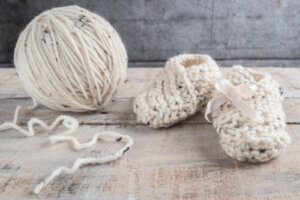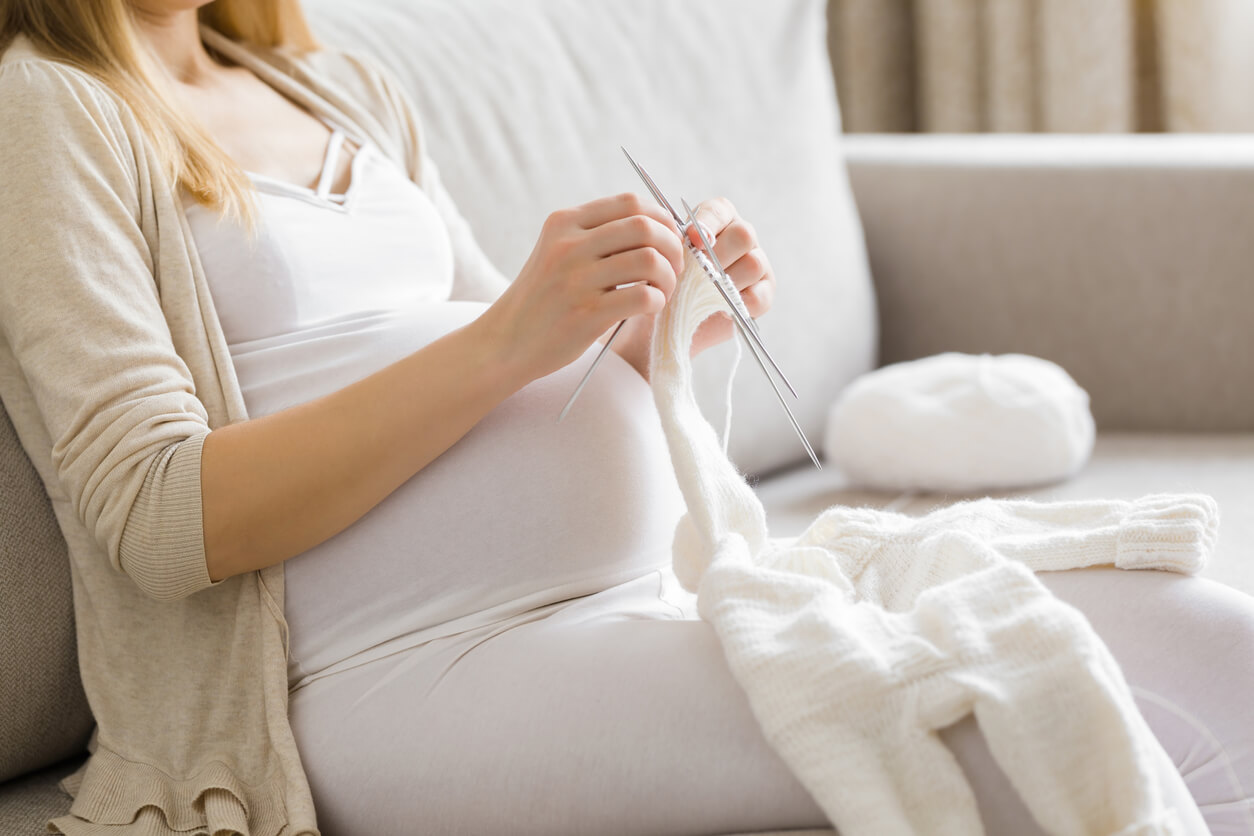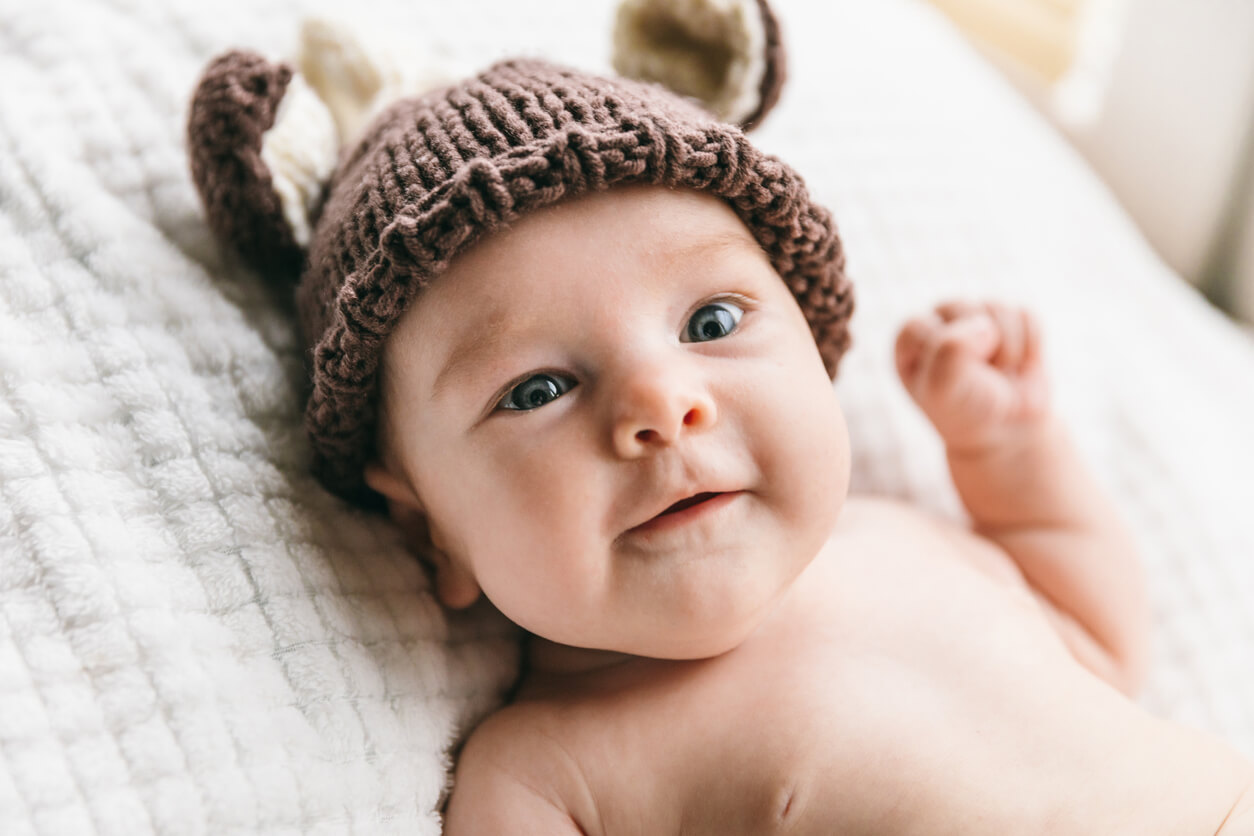What Kind of Yarn is Best for Knitting Baby Clothes?


Written and verified by the dermatologist Maria del Carmen Hernandez
Yarn in baby clothes is best suited to keep them dry, warm, and happy. However, not all types are friendly to their delicate and sensitive skin. This material presents many beneficial properties for little ones, but not all of them are the same. When choosing the best yarn for knitting baby clothes, you should consider different aspects that we’ll tell you about in this article.
Babies’ skin
Babies’ skin is very delicate and fragile, so it can suffer allergic reactions to the different materials that clothes are made of. At the same time, attention should also be paid to the care of clothes that are woven with yarn. In fact, many of them can be washed in washing machines, while others can only be washed by hand so as not to shrink or deform them.
A study by the British Journal of Dermatology concludes that superfine merino wool can be an excellent therapeutic option for childhood atopic disease.
You may be interested in: 10 Natural Remedies for Atopic Skin in Babies
Does yarn irritate babies’ skin?
There are many beliefs that yarn produces itching and irritation to babies’ skin. However, baby clothes made with certain types of this material don’t generate allergic reactions. The wool chosen should be fluffy, soft, free of lint and threads, and have a delicate, medium to fine thickness. These are some of the appropriate ones:

Merino wool
Merino wool fibers have a layer on the outside that makes them softer, similar to silk. This characteristic also makes it more comfortable. The natural attributes make it delicate and pleasant for the baby’s skin, even for those who suffer from skin surface conditions or eczema due to atopy.
In addition, this type of wool helps to keep the child at a comfortable temperature due to its ability to regulate. In other words, the wool fibers absorb moisture caused by perspiration and it’s eliminated in the environment. This product comes from a type of sheep that’s native to North Africa. Therefore, it’s a natural material that weighs little due to the elasticity and thinness of its fibers. At the same time, it acts as a very effective thermal insulator, providing warmth in winter and keeping the child cool in summer.
Organic cotton yarn
This type of yarn is the most recommended for babies or children with allergic skin conditions. This material absorbs perspiration much better and is softer than ordinary cotton. In addition, due to the absence of bleach and pesticides, it’s hypoallergenic for delicate skin. However, although organic cotton, which doesn’t use chemicals in its production and processing, is ideal, it’s also much more expensive.
One of the disadvantages of this product is its lower capacity to generate warmth compared to other yarns. Therefore, it’s advisable to use them in spring and fall and avoid them in colder seasons. On the other hand, some absorbent cottons are sold on the market mixed with bamboo fibers, which makes them silkier and adds anti-allergic, anti-static, and antiperspirant properties.
Read also: Skin Rashes on Babies: What You Should Know
Alpaca wool
Although it’s not so commercialized in different parts of the world, its properties are similar to those of merino wool. It’s hypoallergenic, very light, and capable of regulating the baby’s body temperature. It’s even warmer and more breathable than ordinary wool, which makes it very effective in winter clothing. Unlike other types, alpaca wool doesn’t wear out with use and is also water repellent and flame retardant.

Do knit clothes make babies too warm?
Until 18 months after birth, babies don’t have the ability to regulate their own temperature efficiently and correctly. In fact, this is related to the size of the skin surface compared to their body weight. In general, the smallest babies (especially if they’re premature or sick) tend to dissipate body heat faster if they’re not warm. Therefore, they should be kept warmer than adults. A wool hat is recommended to maintain a warm internal environment, as newborns lose too much heat through their heads.
Knit clothing and babies
Wool clothing can help keep babies comfortable and warm, as well as regulate their body temperature without getting too cold or too hot. In other words, certain types of yarn have thermoregulation properties and provide softness to the skin of little ones. For this reason, when knitting baby clothes, merino, alpaca, or absorbent cottons are recommended, as they have all the beneficial properties.
Yarn in baby clothes is best suited to keep them dry, warm, and happy. However, not all types are friendly to their delicate and sensitive skin. This material presents many beneficial properties for little ones, but not all of them are the same. When choosing the best yarn for knitting baby clothes, you should consider different aspects that we’ll tell you about in this article.
Babies’ skin
Babies’ skin is very delicate and fragile, so it can suffer allergic reactions to the different materials that clothes are made of. At the same time, attention should also be paid to the care of clothes that are woven with yarn. In fact, many of them can be washed in washing machines, while others can only be washed by hand so as not to shrink or deform them.
A study by the British Journal of Dermatology concludes that superfine merino wool can be an excellent therapeutic option for childhood atopic disease.
You may be interested in: 10 Natural Remedies for Atopic Skin in Babies
Does yarn irritate babies’ skin?
There are many beliefs that yarn produces itching and irritation to babies’ skin. However, baby clothes made with certain types of this material don’t generate allergic reactions. The wool chosen should be fluffy, soft, free of lint and threads, and have a delicate, medium to fine thickness. These are some of the appropriate ones:

Merino wool
Merino wool fibers have a layer on the outside that makes them softer, similar to silk. This characteristic also makes it more comfortable. The natural attributes make it delicate and pleasant for the baby’s skin, even for those who suffer from skin surface conditions or eczema due to atopy.
In addition, this type of wool helps to keep the child at a comfortable temperature due to its ability to regulate. In other words, the wool fibers absorb moisture caused by perspiration and it’s eliminated in the environment. This product comes from a type of sheep that’s native to North Africa. Therefore, it’s a natural material that weighs little due to the elasticity and thinness of its fibers. At the same time, it acts as a very effective thermal insulator, providing warmth in winter and keeping the child cool in summer.
Organic cotton yarn
This type of yarn is the most recommended for babies or children with allergic skin conditions. This material absorbs perspiration much better and is softer than ordinary cotton. In addition, due to the absence of bleach and pesticides, it’s hypoallergenic for delicate skin. However, although organic cotton, which doesn’t use chemicals in its production and processing, is ideal, it’s also much more expensive.
One of the disadvantages of this product is its lower capacity to generate warmth compared to other yarns. Therefore, it’s advisable to use them in spring and fall and avoid them in colder seasons. On the other hand, some absorbent cottons are sold on the market mixed with bamboo fibers, which makes them silkier and adds anti-allergic, anti-static, and antiperspirant properties.
Read also: Skin Rashes on Babies: What You Should Know
Alpaca wool
Although it’s not so commercialized in different parts of the world, its properties are similar to those of merino wool. It’s hypoallergenic, very light, and capable of regulating the baby’s body temperature. It’s even warmer and more breathable than ordinary wool, which makes it very effective in winter clothing. Unlike other types, alpaca wool doesn’t wear out with use and is also water repellent and flame retardant.

Do knit clothes make babies too warm?
Until 18 months after birth, babies don’t have the ability to regulate their own temperature efficiently and correctly. In fact, this is related to the size of the skin surface compared to their body weight. In general, the smallest babies (especially if they’re premature or sick) tend to dissipate body heat faster if they’re not warm. Therefore, they should be kept warmer than adults. A wool hat is recommended to maintain a warm internal environment, as newborns lose too much heat through their heads.
Knit clothing and babies
Wool clothing can help keep babies comfortable and warm, as well as regulate their body temperature without getting too cold or too hot. In other words, certain types of yarn have thermoregulation properties and provide softness to the skin of little ones. For this reason, when knitting baby clothes, merino, alpaca, or absorbent cottons are recommended, as they have all the beneficial properties.
All cited sources were thoroughly reviewed by our team to ensure their quality, reliability, currency, and validity. The bibliography of this article was considered reliable and of academic or scientific accuracy.
- Lang N, Bromiker R, Arad I. The effect of wool vs. cotton head covering and length of stay with the mother following delivery on infant temperature. Int J Nurs Stud. 2004 Nov;41(8):843-6. doi: 10.1016/j.ijnurstu.2004.03.010. PMID: 15476757. Disponible en: https://pubmed.ncbi.nlm.nih.gov/15476757/
- Su JC, Dailey R, Zallmann M, Leins E, Taresch L, Donath S, Heah SS, Lowe AJ. Determining Effects of Superfine Sheep wool in INfantile Eczema (DESSINE): a randomized paediatric crossover study. Br J Dermatol. 2017 Jul;177(1):125-133. doi: 10.1111/bjd.15376. Epub 2017 Jun 12. PMID: 28182252. Disponible en: https://pubmed.ncbi.nlm.nih.gov/28182252/
This text is provided for informational purposes only and does not replace consultation with a professional. If in doubt, consult your specialist.








